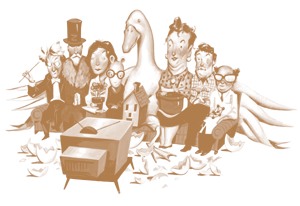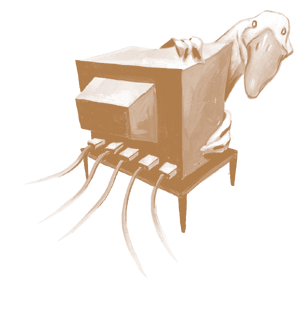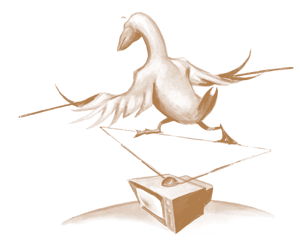Nonprofit Entrepreneurs: How WGBH Markets Its Brands
This broadcaster has built and leveraged powerful commercial brands, all while keeping a careful eye on its nonprofit mission.

Talk to enough people at WGBH and you will repeatedly hear a reference to the "goose," as in the goose that lays the golden egg. For more than 40 years, WGBH has produced an unending string of golden eggs, such as Julia Child's "French Chef," "NOVA," "Mobil Masterpiece Theatre," "Mystery," "This Old House," "The American Experience," "Frontline," "The Victory Garden," "Evening at Pops," "The New Yankee Workshop," "Antiques Roadshow" and "Arthur."
The Boston-based broadcaster, whose sprawling studios adjoin Harvard Business School, has long outshone bigger-market outlets in the public broadcasting system. It produces more than a third of the Public Broadcasting Service's prime-time lineup, is a major source of programs for public radio stations and produces a third of the content for PBS Online. In addition, WGBH operates three public television stations and one public radio station (two more are in the planning stages).
WGBH's familiar logo has become synonymous with high quality; the broadcaster does not have a display case big enough to hold the hundreds of prestigious awards it has won, including Emmys, Oscars and Peabodys. It has, in essence, become public television and radio's Procter & Gamble, building a stable of highly successful branded products that not only enjoy widespread popularity but also engender trust and respect within the broadcaster's customer base. Like all of public broadcasting, WGBH has struggled endlessly to find funding for its productions. During the past decade, the government's contribution has declined substantially, forcing PBS and its various outlets around the country to seek other sources of financing. At the same time, WGBH's success has spawned a raft of competitors, most notably in the ever-expanding cable television marketplace, where successful channels such as A&E, Home & Garden Television and The His-tory Channel have encroached on WGBH's mainstay audience.
As a nonprofit organization, WGBH is constrained from selling advertising to fill its coffers; it receives more than 30 percent of its funding from PBS, the Corporation for Public Broadcasting and other public broadcasting stations. Viewers, corporate underwriters and foundations remain traditional sources of other funds. Yet the shifting realities of the industry and the marketplace have taken the broadcaster in the direction of some pioneering (some would say risky) commercial ventures that walk the fine line between nonprofit and for-profit sectors. They are ventures that the broadcaster would have considered strictly taboo as recently as 20 years ago.
The examples are numerous. WGBH has put its name and logo on Learningsmith Inc., a national chain of retail stores in which it is an investor. It has licensed one of its top brands, "This Old House," to a commercial magazine produced by Time Inc., and discussions are under way for more publishing tie-ins (see sidebar, page 31). It is a prime partner in a successful catalogue business called Signals, and it produces and sells videotapes, books and compact discs.
The broadcaster's commercial ventures - which include publishing and licensing deals, distribution of its products, and home video and foreign royalties - generated gross revenues of $19 million in 1998 with a net income to the broadcaster of $8 million, according to Henry P. Becton Jr., WGBH's president. Although that represents only 5 percent of the broadcaster's $160 million budget, the net income from commercial ventures is growing dramatically, up 20 percent from the year before. That $8 million is put into the broadcaster's discretionary budget and goes to pay for projects that are strapped for funding from the usual sources.
Executives acknowledge that WGBH wrestles with these issues constantly, and when they are confronted with a new commercial opportunity, they come back to the "goose." "If we are the goose that lays the golden egg, our mission is to preserve the good health of the goose," says Peter McGhee, the 64-year-old senior vice president of national production, who has worked for WGBH for 30 years. "We want to maximize the goose for the long term."
To this end, WGBH offers lessons for the nonprofit as well as the for-profit organization in ways to enter new markets, extend brands and maximize revenues without abandoning the corporate mission and alienating its core customer base. Though it does not face the pressures of quarterly earnings statements and anxious shareholders, WGBH nonetheless faces daunting financial pressures, along with vigilant and vocal stakeholders, that have undermined other big players in public television. Public broadcasting outlets such as KCET in Los Angeles and KQED in San Francisco have cut back their original programming budgets significantly while WGBH has flourished. Much can be learned from the best, whether they produce laundry detergent, razor blades or great television.
WGBH wrestles with these issues constantly, and when they are confronted with a new commercial opportunity, they come back to the "goose."

THE IMPORTANCE OF LEADERSHIP
Ronald A. Heifetz, who teaches leadership at Harvard's Kennedy School of Government, says WGBH has excelled at implementing the adaptive work an organization needs to address an uncertain future.
"The essence of adaptive work is to clarify what is of the essence and what is expendable," says Professor Heifetz, who has consulted with WGBH. "WGBH has been meeting the adaptive challenge because it has a long history of innovation and is accustomed to being out front among PBS stations around the country. It is not afraid of pioneering into new territory. And most important, it has had stable, cohesive leadership at the top of the organization that has had the courage to face these changing realities of competition and diminished government funding without putting its head in the sand."
Far from ducking the issues, WGBH attacks the question head on. Indeed, as far back as 1980, the broadcaster hired Brigid Sullivan, a Harvard M.B.A., to start Special Telecommunications Service, a strategic-planning unit. Using the creative talent at WGBH, the unit created joint ventures to produce interactive videodisks for the American Telephone and Telegraph Company; provided online content for the International Business Machines/Sears Prodigy service, and developed distance learning courses, children's programming and video and compact disc offerings. These were all aimed not only at fulfilling WGBH's educational mission but also at providing additional sources of income for the broadcaster. The unit's revenue has mushroomed from $20 million in 1993 to $45 million in 1998.
As the pace intensified, the problem of where and how far to go in the commercial sector grew. One solution was to form in 1995 the WGBH Enterprises Division, a group of executives that meets every two weeks to consider new opportunities and debate the merits and risks of extending its various brands. As chairperson, Ms. Sullivan leads the somewhat boisterous and heated meetings. "We struggle with these issues on a daily basis," Ms. Sullivan says. "There's a lot of fighting and stress. It's very time-consuming and painful."
The meetings provide a forum for all constituencies. Professor Heifetz, who was asked to consult with the Enterprises group, attended four or five meetings. The participants, he noted, always managed to focus on a key question: Can we hold on to what is dear to our creative programming agenda, our public education value set, and yet enter into partnerships that previously we'd seen as tainting the core values of the broadcaster?
"The meetings are combative," Professor Heifetz says, "because this is an organization devoted to creativity. It is already accustomed to people with passionate and different views. That's important.
"Companies allergic to conflict frequently avoid tough questions around which people have legitimately competing perspectives. These meetings in which I assisted were meant to surface these conflicts and provide a model leading to resolutions not only for the top management team but for working groups in the enterprise."
The result has been fresh ideas and new commitments. One of the first decisions was to commit to self-distribution of audio-visual products to schools. WGBH's programming, such as "NOVA," "American Playhouse," "A Science Odyssey," "Mobil Masterpiece Theatre" and a myriad of award-winning specials, has long been used by teachers for enhancing course work. Nearly 90,000 teachers use "NOVA" materials in their classrooms, for example, reaching more than 6.6 million students every year. The broadcaster previously sold its videotapes through distributors for $100 per tape and received a percentage of each sale, but Ms. Sullivan believed there was a better way. WGBH now directly sells the tapes for $20, significantly increasing volume and allowing more schools to afford the tapes, while controlling distribution and costs. "It was the right thing to do, and we not only have a better service but we make more money," she says. The broadcaster now brings in $1 million a year in self-distribution; it garnered less than half that in previous years.
The main mission of the Special Telecommunications Service is to find gaps in public broadcasting's offerings and fill them. The bottom line is not profits but filling an educational need. To this end, WGBH has ventured not only into programming but also into access technologies and interactive, online information resources. The broadcaster has even used its technical and creative expertise to produce large-format IMAX films. Its pioneering work with the Caption Center in the early 1970's put WGBH at the forefront of making television accessible to deaf people and led to the creation of the Descriptive Video Service, which offers access to the blind and visually impaired. As an organization, WGBH has always been clear about what drives its bottom line.
In the early 1990's, for example, Ms. Sullivan noticed that her son had certain learning issues. While seeking advice, she thought, "Shouldn't public television do something about learning disabilities?" She found that others in public broadcasting had been working on the same issue, in terms of both technical delivery and instructional formats. After seven years, the Special Telecommunications Service came up with a project called "All Kinds of Minds" and raised $5 million to produce the television series, a video library, an online component and other multimedia elements. It is scheduled for the fall of 2000.
Another project scheduled for the year 2000 that emanated from the Enterprises division is "Between the Lions," a children's reading series that is being created by Norman Stiles, an Emmy-award-winning writer for "Sesame Street," with his new company, Sirius Thinking. The series, which picks up where "Sesame Street" leaves off, takes place inside a library and features puppets and animation to help children ages 4 to 7 learn to read.
WGBH occasionally attracts projects that commercial television lusts after. "Arthur," the hugely popular children's book series by Marc Brown, had been the target of entreaties from commercial television in the early 1990's, but Mr. Brown resisted, fearing his creation would be exploited and mishandled. When Carol Greenwald, a WGBH producer, approached him, Mr. Brown liked what he heard. As a longtime Boston-area resident, he knew and admired the local station. "It was the only channel my sons were allowed to watch," he says. More important, they shared mutual goals for "Arthur."
"Their agenda for the show was making kids want to read, which was right in alignment with what I wanted to do," Mr. Brown says. In addition, when Mr. Brown asked for involvement in the project, he was given approval power for everything from animators to writers and even the music. "That is very unusual," he says. "But it has worked out very well. It's been a terrific partnership." Since 1995, WGBH has produced 65 episodes of "Arthur," which helped catapult the career of the series' main character, a beloved aardvark, to new heights. During the first 20 years of writing the book, Mr. Brown sold five million copies; in the three years that the television show has aired, he has sold 20 million.
WGBH has benefited from the relationship as well. The broadcaster gets a percentage of all book sales and merchandising related to Arthur, along with a share of international sales of the show, which goes into its discretionary fund. The broadcaster controls all home video sales. It also formed a partnership agreement with the Microsoft Corporation to create what has turned out to be a highly successful Arthur Web site as well as a computerized Actimate Arthur doll that interacts with the television series and desktop computers via an infrared signal.
To Ms. Sullivan, the lessons are simple: "The world is changing and we have to keep rock-and-rolling with it. We have to keep adapting without losing our center. That's the challenge. For me, it's really clear. You stick with the mission of public television and exploit it every which way you can."
THE BECTON FACTOR
If there is a steward for the mission and an arbiter of these ongoing battles about commercialism, it is Henry P. Becton Jr., the president and general manager of WGBH since 1984. Mr. Becton, 55, has been with WGBH since 1970, and as president has overseen tremendous growth and expansion as the complexities of fund-raising and the decline of Federal monies have changed the rules for public broadcasting.
"the generalized problem for all nonprofits is how do you draw the proper value out of your assets without letting your decision-making become overly influenced by the commercial marketplace?"
For Mr. Becton, what WGBH faces is not different from the challenges facing other nonprofits such as museums and symphony orchestras. "The generalized problem for all nonprofits is how do you draw the proper value out of your assets without letting your decision-making become overly influenced by the commercial marketplace?"
Under Mr. Becton's guidance, the broadcaster has pushed further into commercial ventures than ever before. Indeed, longtime viewers of WGBH have noticed the creeping commercialism in such things as promos for corporate underwriters that air between programs (in the old days, a corporate underwriter had to be content with a verbal, on-air thanks). Today, plugs for underwriters have grown longer and more expansive, tightening the gap between simple gratitude and outright Madison Avenue huckstering.
Mr. Becton acknowledges the fine line the broadcaster walks. Noting that PBS was criticized several years ago for not reaping enough of the commercial rewards that the children's show "Barney" generated, he says, "You're damned if you do and damned if you don't." He insists there is a clear difference between sponsorship and outright advertising. "A sponsor is purchasing an association, not trying to establish an imprint," he explains. And he notes that extending brands and finding new revenue streams is really nothing new at WGBH.
He recalls that some of the broadcaster's earliest productions, such as Julia Child's "The French Chef" and Stanley Karnow's series on Vietnam, dabbled in book publishing to accompany broadcast projects. Such endeavors were deemed O.K. because they represented a "clear exten- sion of the mission" while generat- ing a small amount of revenue. Since then, book publishing deals to accompany WGBH productions have become standard operating procedure and a consistent source of income.
Like any battle-weary veteran, Mr. Becton is used to the lightning rod effect that the issue has had on public broadcasting. He does not apologize for WGBH's forays into commercial ventures. In fact, public broadcasting's strength, he says, lies in not being reliant on any one source of funding. Like a savvy investment counselor, he insists on not putting all the golden eggs in one basket. No single source of funding should exceed 25 percent, and by splitting WGBH's income stream among PBS, the Corporation for Public Broadcasting, corporate underwriting, grants, viewer support and commercial endeavors, the broadcaster ameliorates its risks.
Indeed, the commercial enterprises will continue to be a bigger part of the pie, Mr. Becton says, but he never wants them to exceed 20 percent of the total. "Editorially," he says, "our strength is to have a variety of sources. Anything more than 20 percent would make me nervous."
Again, the mantra is "mission first." WGBH executives are quick to point out that programming is chosen because of its value as an educational vehicle, not because of potential ratings points or ad sales. Programs such as the award-winning "Frontline," the last hour-length news documentary series on television, has little commercial value or merchandising opportunities. Neither does "ZOOM," an ambitious children's show that first appeared in the 1970's, was canceled and now has been reborn. "Commercial value has never consciously or explicitly influenced what we've done," Mr. McGhee says. "What we do is influenced by what we can do. A project can justify its existence if it has no other audience than the basic PBS audience."
Unfortunately, the money needed to fund such programming requires a deep well. Mr. McGhee acknowledges that much has changed. "I doubt we brought in $20,000 in premium sales 20 years ago," he says. But with a more tolerant and understanding viewing public, the boundaries have shifted.
Mr. Becton, for example, says that he had long felt that WGBH should have its own version of a museum store and a catalogue for products. But wisely, since the broadcaster had neither skills nor interest in running a retail store or catalogue business, it found partners in both endeavors. In the early 1980's, WGBH made a deal with Minnesota Public Radio, an ambitious and fast-growing enterprise that produces "Prairie Home Companion," among other programming. Minnesota Public Radio's owner ran a separate for-profit, commercial company that began the Wireless catalogue in the early 1980's for friends of public radio. Signals, for public television, was started in 1985. Today, the Signals catalogue offers an eclectic mix of products, from videotapes of public television series (not just from WGBH) to clothing, art, books, jewelry, home and garden furnishings and children's toys. An unsuspecting reader might mistake the catalogue as an offering from Hammacher Schlemmer or Hearthsong or any number of commercial mail-order companies. But WGBH reaps more than $2 million annually from Signals sales and has not alienated its viewers with the commercial flavor of the catalogue.
"when you market anything, you've got to have more than one customer. That's where the leverage is."

LEARNINGSMITH
Creating a retail outlet for WGBH-related products was also a dream best realized with a partner. "We didn't have the captive space that a museum has and we didn't want to become retailers," Mr. Becton explains.
What WGBH did have was exceptional business people among its management staff, including Andrew Griffiths, WGBH's treasurer and vice president for finance and administration. Mr. Griffiths says that the broadcaster's ability to successfully balance its commercial endeavors with the organization's mission is due to two forces. "Within our Enterprises area, we've got some sharp, aggressive business minds, constantly coming up with new ideas for generating revenues," Mr. Griffiths says. "And within our board, we are very cautious about entering into any new areas. We're fairly conservative on the editorial side."
Being in a lot of businesses, he adds, the key is to "do enough homework to know reasonable comparables and negotiate around that. When you market anything, you've got to have more than one customer. That's where the leverage is."
One notable exception was WGBH's decision to finally seek its retail outlet in the early 1990's. Rather than go out for bids, the broadcaster approached Marshall Smith, a Boston-based entrepreneur and retailer who had built a successful local bookstore chain called Paperback Booksmith. The original concept was to create a small retail outlet to distribute WGBH video projects, but once the broadcaster got involved with Mr. Smith, the vision changed and grew. Mr. Smith said he would be willing to invest $500,000 to open the store and WGBH agreed to match that.
WGBH Learningsmith opened its first store in the upscale Chestnut Hill Mall in Newton, Mass. in 1991. Rather than a cramped video outlet, the new store was big, open and designed for New Age retailing. The store's motto was "a general store for the curious mind." The original concept had been expanded dramatically from videos to include a wide variety of merchandise, from software and games to puzzles and toys. The store was designed for all age groups and was intended to be hands-on, especially with computer software. Much of the merchandise is related to WGBH and other PBS programming, from "Arthur" to "NOVA."
WGBH agreed to a two-layered relationship with the chain. It receives royalties for WGBH-related merchandise along with veto power over merchandise and promotion, a right it has never invoked. Mr. Griffiths says the broadcaster received nearly $200,000 in royalties in 1998. WGBH also owns a 5 percent stake in the privately held company and has a chance to more than recoup its initial investment if and when the company goes public.
The original concept for Learningsmith called for a rollout of stores around the country; each store would forge a relationship with a public broadcasting outlet in its region. The call letters of the station would accompany Learningsmith on the local signage. Though the chain flourished and expanded, the idea to link up with local PBS stations never caught hold outside the Boston area, and WGBH is the only PBS outlet that maintains such a relationship with the chain. Learningsmith now has 88 stores around the country.
"The WGBH name means a lot to us in Boston," says Janet Emerson, president and chief executive officer of Learningsmith. "It represents a lot of business for us because we offer WGBH members a discount in our store. People also feel a real connection and loyalty because of WGBH. There is a trust that is evoked. It's like the Good Housekeeping seal of approval."
For WGBH, the relationship perfectly embodies Mr. Becton's concept of commercial tie-ins. "It earns us a revenue stream without diverting management attention to it," Mr Becton explains.
STRATEGIC PLANNING
Mr. Becton's success may lie in his time-honed ability to be a creative pragmatist. When the Federal funding battles broke out six years ago, he did not spend much time fighting what had long been a one-sided war. Instead he reconsidered ways to strengthen WGBH's revenue streams. He carefully focused on four strategies:
1. Increase membership. Despite the broadcaster's constant on-air fund-raising (with carrots like taped concerts by the Three Tenors, James Taylor and John Tesh) and its highly successful annual fund-raising auction, Mr. Becton felt that viewer support remained an underdeveloped resource. The broadcaster, in a joint effort with PBS and WNET in New York, brought in Jonathan Abbott, a PBS veteran, to build a database program aimed at increasing membership. Mr. Becton relinquished the general manager's role to Mr. Abbott last year. The idea is to enter and track the attributes of each individual donor and tailor marketing specifically to that donor's interests. Increasing use of the Internet and personalized e-mail enhanced the ability to market to a segment of one.
While public broadcasting's membership has generally remained flat, WGBH has expanded its membership steadily, 8 percent a year for the past three or four years, from 160,000 to 200,000 in that time. "Even though we are in a mature market, management focus on this has made the difference," Mr. Becton says.
2. Initiate a $33 million capital campaign. WGBH had to find a way to offset cuts in government funding and raise money for the broadcaster's endowment, its program ventures and technology.
3. Increase underwriting and corporate funding. Mr. Becton realized that WGBH's sales efforts aimed at major corporations were inefficient and "extremely user unfriendly." Producers of each major broadcast project had their own sales team pitching their own individual projects. Corporations grew confused and annoyed at pitches coming from all angles. Using a management consultant, WGBH reengineered its corporate fund-raising efforts by consolidating all its salespeople into a single group called The PBS Sponsorship Group. A relationship manager was assigned to each major company and the effect was immediate. Corporate underwriting jumped 22 percent in just one year after the new effort was instituted.
4. Increase commercial opportunities. WGBH executives see only a wealth of sales opportunities for its products. Its Web site (www.WGBH. org) features an online boutique of WGBH products, from videos to T-shirts, available from its various productions. Though the broadcaster continues to refrain from overt product sales - you will not see Norm Abram from "This Old House" hawking Sears Craftsman tools anytime soon - the constraints on reaping financial rewards from its brands have loosened significantly. And WGBH continues to explore opportunities.
An enterprise as volatile and fluid as a public broadcasting station is a work in progress. As the commercial networks have wrestled with the onslaught of cable and direct satellite broadcasting, WGBH has turned the struggle for survival on its ear.
An enterprise as volatile and fluid as a public broadcasting station is a work in progress. As the commercial networks have wrestled with the onslaught of cable and direct sa- tellite broadcasting, WGBH has turned the struggle for survival on its ear.
"Henry Becton has done an extraordinary job in his courage to face reality with a creative optimism that a way could be found," says Harvard's Professor Heifetz. "WGBH had to be proactive in educating customers as well as other primary constants and sources of funding to see that the organization was not losing itself, or up for sale. Instead, it was enriching itself by facing reality and, in the end, delivering even better product and expanding its own network of interested collaborators. Of course, it's not without pain. It's always painful for people to have to do the hard work of figuring out what is essential and what is expendable."
As an educational foundation, WGBH is always cognizant of lessons learned. "What we've tried to do is build up a portfolio of brands and franchises," Mr. Becton says. "Some stand on their own, some do not - and those need to be subsidized by others that do."
Not surprisingly, quality remains the bellwether. Understanding the product attributes that different customers value, a crucial mandate in selling automobiles, services or television, is key, as is the ability to extend those brands while staying true to the same attributes.
In that way, WGBH has created a community around its product, a community determined not so much by income but by an intellectual curiosity and a search for self-improvement.
"You have to keep that community in mind," Mr. Becton says. "It's those common attributes of your audience along with their value system that you are programming for."
This Old House
When Russell Morash produced his first how-to program, "The French Chef," for WGBH in 1962, he could not have imagined what he was setting in motion. In the 37 years since Julia Child first uttered "Bon appetit!" to a nascent Boston public television audience, Mr. Morash has created a string of hits, including "This Old House," "Victory Garden" and "The New Yankee Workshop." In so doing, he has changed the face of commercial television as well.
The concept of programming that instructs and informs in an entertaining way - the heart of the WGBH programming mission - was once thought to be too boring and staid for a wide commercial audience. Mr. Morash and WGBH helped change that attitude over the past three decades by creating a consistent programming formula that tapped into America's love affair with how things work. Mr. Morash figured out a way to turn creating a souffle or finishing a black walnut vanity into entertainment. And his eye for quirky, ingratiating on-air talent turned unlikely candidates - Julia Child, Jim Crockett, Bob Vila and Norm Abram - into television stars.
With the advent of cable television, Mr. Morash's formula spawned a tidal wave of copycat programming, culminating in entire cable channels devoted to how-to programming such as The Learning Channel and Home & Garden Television, which are among the fastest-growing cable channels.
It is the how-to shows that most attract advertisers and marketers. "This Old House," for example, has been a PBS hit for 20 years and evolved from a cult classic for home improvement buffs to a genuine television institution. It has a weekly audience of seven million viewers on 323 PBS stations, reaching 97 percent of American households, and is the highest rated home-improvement program on all television stations, public or commercial.
The show has spawned a successful line of books and videos, and episodes from the past now appear regularly on cable television. Its first host, Bob Vila, quickly became a PBS star, left the show and continued a successful commercial career as host and pitchman. The show's unlikely hero, Norm Abram, a shy and unassuming carpenter from Hudson, Mass., has become a cult hero to millions of devoted fans of "This Old House" and his other hit show, "The New Yankee Workshop."
The opportunity to cash in is strong. Indeed, "This Old House" has never received any PBS funding, according to Mr. Morash, which forced the producer to turn to corporate underwriters such as Ace Hardware, State Farm Insurance and Krylon Paints to support the program.
But Mr. Morash has been a stern guardian of his brands and has generally been adamant about turning away commercial opportunities that would undermine the trust his programs have built among the viewers. He points out that Julia Child never endorsed any products when she hosted her famous cooking show, and Mr. Morash went so far as to order all labels of products, from mustard to salt, to be obscured.
Mr. Morash was far more lenient about book and, later, video deals for his programs. Because the broadcaster could not pay hosts big salaries, they were rewarded with sometimes lucrative book deals. For instance, Mr. Morash recalled a contract for "Crockett's Victory Garden," a companion book to the series, which was published in the mid-1970's and spent more than a year on The New York Times' best-seller list. It was the first successful "product" from one of his shows, and both he and the late Mr. Crockett received royalties from book sales.
Much has changed in recent years, and WGBH has loosened its once vise-like grip on its public charter. Now shows like "The New Yankee Workshop," for example, offer a catalogue of wares including videos of building lessons along with caps, T-shirts and sweatshirts with the show's logo.
But Mr. Morash's most ambitious venture into the commercial world thus far is This Old House magazine. A fully commercial entity from Time Inc., supported by advertising sales, This Old House magazine began publishing in 1996. It has already grown into a highly successful publication with 650,000 subscribers and an audited pass-along readership of seven million. Eric Thorkilsen, the magazine's creator and publisher, says it will turn profitable next year.
In 1994, when Mr. Thorkilsen met with Mr. Morash, he suggested that the deal include other commercial licenses for past programs and perhaps books that would accompany the magazine. "We wanted to be a one-stop shopping outlet for 'This Old House' licenses," Mr. Thorkilsen said.
Reluctantly, Mr. Morash and WGBH agreed. They were swayed by several factors: Time Inc. and Mr. Thorkilsen already had experience with the melding of television and magazines through a connection to Martha Stewart. WGBH would retain full veto power over the contents and design of the magazine and other commercial ventures. And Time Inc. was prepared to invest millions in the development of the brand, even though WGBH retained full ownership of the show.
"I understand that the people deeply believe in the mission," Mr. Thorkilsen says. "That's why they work there and not in commercial television." But the business reality is that the show is a big revenue eater and cannot be produced without more and more funding. After three years, all sides are pleased.
Time Inc. has pumped $20 million into the magazine since its inception, which is more than WGBH has been able to spend to promote the brand in 20 years of broadcasting. Time Inc. also has exclusive licensing rights to redistribute episodes of "This Old House" that are two years or more out of public television distribution. That gives them 17 years' worth of programming to sell to the likes of Home & Garden Television and syndicated outlets around the country. Already, the HGTV channel features six hours' worth of Mr. Morash's shows every day, including "The New Yankee Workshop" and "Victory Garden." And despite worries about loyal viewers, few have complained about the commercials that now interrupt the shows and have forced them to be cut from 30 minutes to 22 minutes.
Mr. Thorkilsen would not reveal the numbers, but said the sublicensing deal provides "significant profits" for WGBH. The magazine gets a distribution fee for brokering the deal between WGBH and the cable outlets. Sensitive to its audience, the magazine has carefully nurtured its relationship to the show. Mr. Thorkilsen has already published several instructional books from the editors of the magazine, but those are about how to use tools. No brands are recommended. He is also exploring an online advice business for consumers who want to tap into the expertise of show staffers.
Bruce Irving, the producer of "This Old House" for more than 10 years, says the magazine is simply doing things that the makers of the show are not good at. "We don't want to Martha Stewart ourselves," Mr. Irving says adamantly. [Gracious living guru] "Martha Stewart is much ridiculed and her message is lost in her ubiquitous nature. We don't want to be that way. We make shows about fixing houses. We don't know anything about making tools, clothes or children's blowpops with 'This Old House' written on them."
For Mr. Morash, stretching toward commercial boundaries is not troubling. He says the essence of the issue is that the show has established a level of excellence that consumers cannot get elsewhere. This has engendered a level of trust in the audience that is at the heart of the relationship and the show's popularity.
Mr. Morash noted that he once considered selling a line of seeds with the "Victory Garden" logo on them, but couldn't figure out how to maintain the level of excellence that would be required.
"You can hire somebody to take control," he says, "and that's just when you lose control." ![]()
Reprint No. 99304
| Authors
Glenn Rifkin, glennrifkin@worldnet.att.net Glenn Rifkin has covered technology for the New York Times and has written for the Harvard Business Review and Fast Company. He is coauthor of Radical Marketing (HarperBusiness, 1999) and The CEO Chronicles (Knowledge Exchange, 1999). |




